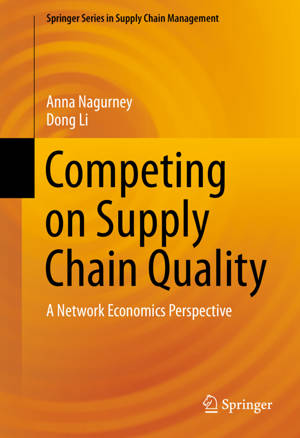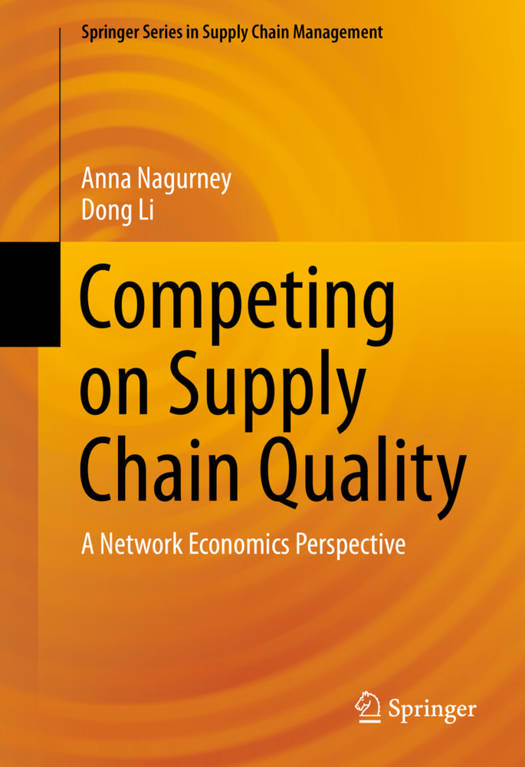
- Afhalen na 1 uur in een winkel met voorraad
- Gratis thuislevering in België vanaf € 30
- Ruim aanbod met 7 miljoen producten
- Afhalen na 1 uur in een winkel met voorraad
- Gratis thuislevering in België vanaf € 30
- Ruim aanbod met 7 miljoen producten
Zoeken
€ 153,95
+ 307 punten
Uitvoering
Omschrijving
This book lays the foundations for quality modeling and analysis in the context of supply chains through a synthesis of the economics, operations management, as well as operations research/management science literature on quality. The reality of today's supply chain networks, given their global reach from sourcing locations to points of demand, is further challenged by such issues as the growth in outsourcing as well as the information asymmetry associated with what producers know about the quality of their products and what consumers know. Although much of the related literature has focused on the micro aspects of supply chain networks, considering two or three decision-makers, it is essential to capture the scale of supply chain networks in a holistic manner that occurs in practice in order to be able to evaluate and analyze the competition and the impacts on supply chain quality in a quantifiable manner.
This volume provides an overview of the fundamental methodologies utilized in this book, including optimization theory, game theory, variational inequality theory, and projected dynamical systems theory. It then focuses on major issues in today's supply chains with respect to quality, beginning with information asymmetry, followed by product differentiation and branding, the outsourcing of production, from components to final products, to quality in freight service provision. The book is filled with numerous real-life examples in order to emphasize the generality and pragmatism of the models and tools. The novelty of the framework lies in a network economics perspective through which the authors identify the underlying network structure of the various supply chains, coupled with the behavior of the decision-makers, ranging from suppliers and manufacturers to freight service providers. What is meant by quality is rigorously defined and quantified. The authors explore the underlying dynamics associated with the competitive processes along with the equilibrium solutions. As appropriate, the supply chain decision-makers compete in terms of quantity and quality, or in price and quality. The relevance of the various models that are developed to specific industrial sectors, including pharmaceuticals and high technology products, is clearly made. Qualitative analyses are provided, along with effective, and, easy to implement, computational procedures. Finally, the impacts of policy interventions, in the form of minimum quality standards, and their ramifications, in terms of product prices, quality levels, as well as profits are explored. The book is filled with many network figures, graphs, and tables with data.
This volume provides an overview of the fundamental methodologies utilized in this book, including optimization theory, game theory, variational inequality theory, and projected dynamical systems theory. It then focuses on major issues in today's supply chains with respect to quality, beginning with information asymmetry, followed by product differentiation and branding, the outsourcing of production, from components to final products, to quality in freight service provision. The book is filled with numerous real-life examples in order to emphasize the generality and pragmatism of the models and tools. The novelty of the framework lies in a network economics perspective through which the authors identify the underlying network structure of the various supply chains, coupled with the behavior of the decision-makers, ranging from suppliers and manufacturers to freight service providers. What is meant by quality is rigorously defined and quantified. The authors explore the underlying dynamics associated with the competitive processes along with the equilibrium solutions. As appropriate, the supply chain decision-makers compete in terms of quantity and quality, or in price and quality. The relevance of the various models that are developed to specific industrial sectors, including pharmaceuticals and high technology products, is clearly made. Qualitative analyses are provided, along with effective, and, easy to implement, computational procedures. Finally, the impacts of policy interventions, in the form of minimum quality standards, and their ramifications, in terms of product prices, quality levels, as well as profits are explored. The book is filled with many network figures, graphs, and tables with data.
Specificaties
Betrokkenen
- Auteur(s):
- Uitgeverij:
Inhoud
- Aantal bladzijden:
- 383
- Taal:
- Engels
- Reeks:
- Reeksnummer:
- nr. 2
Eigenschappen
- Productcode (EAN):
- 9783319254494
- Verschijningsdatum:
- 9/06/2016
- Uitvoering:
- Hardcover
- Formaat:
- Genaaid
- Afmetingen:
- 156 mm x 234 mm
- Gewicht:
- 752 g

Alleen bij Standaard Boekhandel
+ 307 punten op je klantenkaart van Standaard Boekhandel
Beoordelingen
We publiceren alleen reviews die voldoen aan de voorwaarden voor reviews. Bekijk onze voorwaarden voor reviews.








